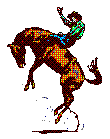Tips for "Multi-User" Trail Riders
By ASGRA member Ken Withers


Not all of us in ASGRA are accomplished rodeo athletes, believe it or not. While we all love the sport and may even find ourselves in the arena occasionally, I would venture to say that most of us are more comfortable participating in the trail rides or stomping around the horse farm. We're certainly more comfortable afterwards. But trail riding is not a no-brainer. It is a skill, different from the skills needed in the arena. Any of us who ride horseback on public multi-user trails, where we can encounter cyclists, backpackers, roller-bladers, joggers, and even whiteface-painted mimes, knows how valuable multi-user trail riding skills can be.
There are good reasons to ride on multi-user trails. Public equestrian-only trails are few and far between, and using private trails can become an expensive (or unlawful) habit. Public multi-user trails, on the other hand, are all around us. They are usually longer, more scenic, and offer a wider variety of outdoor experiences. As more railroad, canal, utility and riparian rights-of-way come into the public domain, more multi-user trails are being constructed. It's not a practical use of limited public resources to build exclusive bridal paths or even double-wide trails with separate lanes for separate uses. And for many of us, the simple fact that the trail is multi-user is a plus in and of itself--that may be the very reason we're on a pubic trail.
But everyone has a horror story, or a friend of a friend with a horror story, of an unfortunate confrontation with a mountain biker or backpacker resulting in multiple injuries, permanently spooked horses, and large insurance settlements.

Professional park managers can cite statistics showing that such incidents are rare, and nearly all that do occur could have been avoided if the participants, human and equine, had some better training. Dr. Roger L. Moore, Associate Professor of Parks, Recreation and Tourism Management at North Carolina State and a leading expert in trail management, doesn't believe that there are fundamental trail use conflicts at all, and no reason to ban or segregate any reasonable trail use. Based on his exhaustive studies, Dr. Moore believes that trail conflicts should be viewed as user behaviors that interfere with other users' reasonable goals and expectations.
Of course, trail user conflict management is a two-way proposition, even (or especially) if the trail is single track. Equestrians, cyclists, backpackers and other users all have rights and responsibilities, and the chief responsibility is to have the skills and common sense to avoid conflicts whenever possible. So here are some trail riding tips for equestrians, followed by some reasonable expectations we should have of cyclists and backpackers.
Equestrians should understand their horses.
Some essential facts to always keep in mind are:- Horses recently descended from animals that roamed and grazed open savannas. They are not naturally comfortable in a confined space, like a narrow trail through the woods or mountains, unless they are familiar with it.
- Horses have an incredible range of vision (340 degrees), but are colorblind and have limited depth perception. A cyclist or a backpacker appearing for the first time in peripheral vision could look like a big scary monster.
- The horse's best natural defense is flight. Given a decent head start, no natural predator in the world, lions and cheetahs included, can catch them. Bolting and running is their instinct, when threatened. The horse's second line of defense is to kick, but only when it feels cornered or restricted when threatened.
- Audibly greet the approaching user and maintain eye contact whenever possible.
- Slow the horse to a walk and move to one side of the trail, giving the cyclist or backpacker ample room to pass. If the trail is on a hillside, move your horse to the uphill side and give the downhill side to the cyclists or backpacker.
- In a friendly manner, audibly or visually indicate to the other trail user that they should slow down and move to the opposite side of the trail.

- Do not encourage the trail user to approach or pet your horse unless everyone is at a dead stop and the horse is quite calm.
- If the horse is calm, use your own judgment to allow visual, audio, and tactile contact. In the long run, it is much better to have your horse get used to the sight of bicycles, helmets, backpacks, and walking sticks. It's good for the other users, too, who are often afraid of horses. This is also a sure-fire way to get a date with a cute cyclist.
- Once you are aware that a cyclist or backpacker is approaching you from behind, slow to a walk and move to one side of the trail.
- If possible, establish audio or visual contact with the other user and indicate that you want them also to also down and move to the opposite side of the trail.
- It is usually not necessary to stop your horse, unless the users behind you are not slowing down or are particularly distracting (for example, a gaggle of noisy mountain bikers).
- Consider the protocols listed above in regards to user contact with your horse.
- Cyclists should know to slow down and yield when approaching an equestrian from either direction.
- Backpackers and cyclists should make their presence known, especially when approaching a horse from behind. Voice is better than bells or horns.
- All users should know not to physically approach a horse without permission of the rider.

- ATV users should know to move to one side of the trail and shut their engines down when approached by a horse, and to never attempt to overtake a moving horse and rider on the trail
- Users have a reasonable expectation that the horseback rider knows the horse and what he or she is doing.
- Consider bringing carrots on your next trail ride. If you allow your horse to snack at all (another issue), you might want to toss a carrot to a friendly hiker or cyclist and ask that they feed the carrot to your horse. If your horse begins to think of other users as potential sources of snacks, he or she will be much easier to handle. Some mountain biking clubs have "carrot days," where they bring sacks of carrots to give to horses they encounter on the trail.
- In California, a cycling club called Responsible Organized Mountain Pedalers holds an annual trail ride with an equestrian club. The event is called "ROMP and Stomp" and is quite popular.
- In Tennessee, the Blue Ridge Riders equestrian club got together with the local chapter of the Sierra Club and a cycling club to produce a safety flier that is distributed across the state. Elsewhere, equestrians and other trails users are involved in joint trail maintenance projects and even hold horse/cycle "rodeo" events.
A few years ago Clemson University sponsored a national symposium of horse trails. One of the speakers, Michael Kelley of the International Mountain Bicycling Association, summed up his presentation by saying, "Both equestrians and cyclists can - learn to withstand just about anything-even each other, despite often heard protestations to the contrary... We share the wonder at what we are able to experience on our chosen steeds. We love the beauty of the outdoors and the joy of life we breathe as we travel through wild lands. We revel in sports which require exquisite balance and self-control, and which inherently involve a certain amount of risk and exposure to injury should we loose our balance or control of what's under the saddle. We get saddle sores and sore backs. The more time we devote to our respective sports, the more likely we are to put every spare dollar into it. We grow attached to our mounts, give them names, groom and maintain them. We relish the wind whistling in our ears from a swift run along an open trail... So take a cyclist to lunch."
We love the beauty of the outdoors and the joy of life we breathe as we travel through wild lands. We revel in sports which require exquisite balance and self-control, and which inherently involve a certain amount of risk and exposure to injury should we loose our balance or control of what's under the saddle. We get saddle sores and sore backs. The more time we devote to our respective sports, the more likely we are to put every spare dollar into it. We grow attached to our mounts, give them names, groom and maintain them. We relish the wind whistling in our ears from a swift run along an open trail... So take a cyclist to lunch."
For more information:
Roger L. Moore, "Conflicts on Multiple-Use Trails: Synthesis of the Literature and State of the Practice,"
About the author:
Ken Withers is a "Silver Spur" member of Atlantic States Gay Rodeo Association, a life member of the League of American Bicyclists, and was recipient of the East Coast Greenway Association's first Lifetime Achievement Award for his trail advocacy efforts.
Photo Credit
Cowboy_biker - Photo courtesy International Mountain Bicycling Association http://www.imba.com
